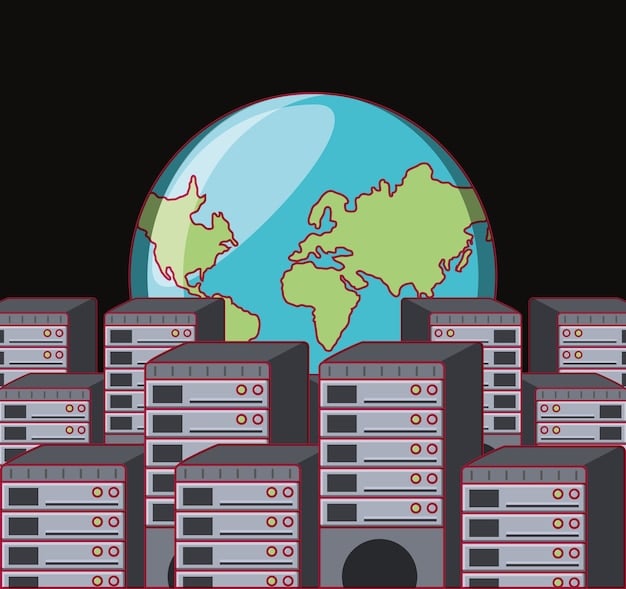Cloud Networking Disaster Recovery: Ensure 99.99% Uptime in the US

Cloud networking disaster recovery is crucial for US businesses aiming for 99.99% uptime, involving strategies like redundancy, failover, and robust security to minimize disruptions and ensure business continuity in the face of unforeseen events.
In today’s fast-paced digital landscape, ensuring business continuity is paramount. For US-based operations, a robust cloud networking disaster recovery plan is not just a luxury; it’s a necessity to guarantee 99.99% uptime and minimize potential disruptions.
Understanding Cloud Networking Disaster Recovery
Cloud networking disaster recovery is a strategic approach to safeguarding critical data and applications by leveraging cloud infrastructure. It’s about creating a resilient network that can withstand unforeseen events and maintain operational continuity.
What is Cloud Networking?
Cloud networking refers to the infrastructure and services that enable network capabilities to be delivered via a cloud-based model. This includes virtualized network functions, software-defined networking (SDN), and network-as-a-service (NaaS).
Why is Disaster Recovery Important?
Disaster recovery (DR) is essential for minimizing downtime and data loss in the event of a disruptive event, such as natural disasters, cyberattacks, or hardware failures. A well-designed DR plan ensures that businesses can quickly recover and resume operations.
Here are some key benefits of cloud networking disaster recovery:
- Reduced Downtime: Minimizes the impact of disruptions, ensuring business continuity.
- Data Protection: Protects critical data from loss or corruption.
- Cost Efficiency: Cloud-based solutions offer flexible pricing and scalability.
- Improved Resilience: Enhances the overall resilience of the network infrastructure.
In essence, cloud networking disaster recovery provides US businesses with a reliable and cost-effective way to protect their operations and maintain a competitive edge.

Key Components of a Cloud Networking Disaster Recovery Plan
A comprehensive cloud networking disaster recovery plan consists of several essential components, each playing a crucial role in ensuring business continuity. These elements work together to create a resilient and reliable framework.
Risk Assessment and Business Impact Analysis
Identifying potential threats and understanding their impact on business operations is the first step. This involves assessing vulnerabilities, analyzing risks, and determining the criticality of various systems and data.
Redundancy and Replication
Implementing redundancy across network components and replicating data to multiple locations are critical for minimizing downtime. This ensures that if one system fails, another can quickly take over.
Consider these key redundancy strategies:
- Geographic Redundancy: Distributing network resources across different geographic locations to protect against regional disasters.
- Hardware Redundancy: Implementing redundant hardware components, such as servers, routers, and switches, to minimize single points of failure.
- Data Replication: Replicating critical data to multiple storage locations to ensure data availability in the event of a disaster.
By incorporating these components, businesses can create a robust cloud networking disaster recovery plan that minimizes the impact of disruptions and ensures 99.99% uptime.
Strategies for Achieving 99.99% Uptime
Achieving 99.99% uptime requires a combination of strategic planning, technological implementation, and continuous monitoring. Several strategies can be employed to reach this level of reliability.
Automated Failover Mechanisms
Implementing automated failover mechanisms ensures that systems automatically switch to backup resources in the event of a failure. This minimizes downtime and ensures continuous operation.
Real-time Monitoring and Alerting
Real-time monitoring of network performance and proactive alerting can help identify and address potential issues before they escalate into full-blown disruptions. This allows for timely intervention and prevents downtime.
Effective strategies include:
- Comprehensive Monitoring Tools: Utilizing tools that provide real-time visibility into network performance, security threats, and resource utilization.
- Proactive Alerting Systems: Setting up alerts that trigger when critical thresholds are breached, allowing for immediate response.
- Regular Performance Audits: Conducting periodic audits to identify areas for improvement and optimize network performance.
By implementing these strategies, US operations can enhance their resilience and maintain 99.99% uptime even in the face of unforeseen challenges.

Selecting the Right Cloud Provider for Disaster Recovery
Choosing the right cloud provider is a critical decision that can significantly impact the effectiveness of your disaster recovery plan. Consider factors such as service level agreements (SLAs), security measures, and geographic diversity.
Service Level Agreements (SLAs)
SLAs define the level of service you can expect from your cloud provider, including uptime guarantees and response times for resolving issues. Ensure that the SLA meets your business requirements.
Security Measures
Evaluate the security measures implemented by the cloud provider, including data encryption, access controls, and compliance certifications. These measures are essential for protecting your data from unauthorized access and cyber threats.
Key considerations include:
- Data Encryption: Ensuring that data is encrypted both in transit and at rest to protect against unauthorized access.
- Access Controls: Implementing strict access controls to limit who can access critical resources and data.
- Compliance Certifications: Verifying that the cloud provider meets industry-specific compliance requirements, such as HIPAA or PCI DSS.
Careful selection of a cloud provider can provide US operations with a secure, reliable, and cost-effective disaster recovery solution, supporting 99.99% uptime.
Best Practices for Cloud Networking Disaster Recovery in the US
Implementing best practices is essential for maximizing the effectiveness of your cloud networking disaster recovery plan. These practices ensure that your plan is well-designed, properly executed, and continuously improved.
Regular Testing and Drills
Conducting regular testing and drills helps identify weaknesses in your disaster recovery plan and ensures that your team is prepared to respond effectively in the event of a real disaster. These tests should simulate various scenarios to validate the plan’s effectiveness.
Documentation and Training
Maintaining comprehensive documentation of your disaster recovery plan and providing regular training to your team are critical for ensuring that everyone knows their roles and responsibilities. This includes documenting procedures, contact information, and recovery steps.
Essential components include:
- Detailed Procedures: Documenting step-by-step procedures for each aspect of the disaster recovery plan.
- Contact Information: Maintaining up-to-date contact information for key personnel, cloud providers, and other stakeholders.
- Training Programs: Conducting regular training sessions to ensure that the team is familiar with the plan and their roles.
Adhering to these best practices enables US operations to create a resilient cloud networking disaster recovery plan that supports 99.99% uptime and minimizes the impact of disruptions.
Future Trends in Cloud Networking Disaster Recovery
The field of cloud networking disaster recovery is constantly evolving, with new technologies and approaches emerging to address the ever-changing threat landscape. Staying informed about future trends can help you proactively adapt your strategy and maintain a competitive edge.
Artificial Intelligence (AI) and Machine Learning (ML)
AI and ML are being increasingly used to automate disaster recovery processes, improve threat detection, and optimize network performance. These technologies can help identify anomalies, predict potential failures, and automate failover procedures.
Edge Computing
Edge computing involves processing data closer to the source, reducing latency and improving performance. This can be particularly beneficial for disaster recovery, as it allows for faster recovery times and minimizes data loss.
Emerging trends include:
- AI-Powered Threat Detection: Using AI to analyze network traffic and identify potential security threats in real-time.
- Automated Failover: Implementing ML-driven systems that automatically trigger failover procedures based on real-time conditions.
- Edge-Based Data Backup: Storing backup data closer to the source to minimize latency and improve recovery times.
By staying abreast of these future trends, US operations can leverage the latest technologies to enhance their cloud networking disaster recovery capabilities and ensure 99.99% uptime.
| Key Aspect | Brief Description |
|---|---|
| 🛡️ Redundancy | Ensures data and systems are duplicated for quick failover. |
| ⏰ Real-time Monitoring | Proactively identifies and addresses potential issues. |
| ☁️ Cloud Provider | Selecting a reliable provider with robust SLAs and security. |
| ⚙️ Regular Testing | Validates the effectiveness of the disaster recovery plan. |
FAQ
▼
The primary goal is to ensure business continuity by minimizing downtime and data loss in the event of a disruptive event, ensuring operations remain functional.
▼
Redundancy provides backup systems and data replication, allowing quick failover to prevent service interruptions when primary systems fail, ensuring continuous operation.
▼
Real-time monitoring helps detect potential issues before they escalate, enabling proactive intervention and preventing downtime, thus ensuring high availability of the network.
▼
Consider factors like SLAs, security measures, compliance certifications, and geographic diversity to ensure the provider meets your business needs and can protect your data effectively.
▼
Regular testing validates the effectiveness of the DR plan, identifies weaknesses, and ensures the team is prepared to respond effectively, minimizing the impact of potential disruptions.
Conclusion
Implementing a robust cloud networking disaster recovery plan is critical for US operations aiming to achieve 99.99% uptime. By understanding the key components, employing effective strategies, and staying informed about future trends, businesses can build a resilient and reliable network that ensures business continuity.





